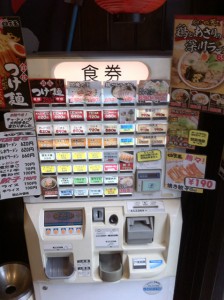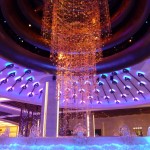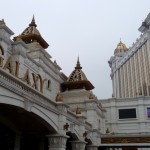I love the casual dining experience in Japan. And by casual, I mean something between fast food and high-end sit down restaurants. The closest thing I can think of in the States are places that people sit down for a quick bite during lunch, Thai food, Applebees, diners, but it’s different here, and that’s why I like it. My favorite restaurants so far are the ones with the vending machines to order from before you sit down:

In the US, eating is an experience. An event. In Japan, it’s a necessity of life. You eat and move on. In Japan, you order your food, sit down at long tables next to strangers, have some green tea (free), the server brings you your food, and when you’re done, you walk away. If you’re at a place with a menu, you sit down, with or without a friend, they take your order, the check comes before the meal is over, and always separate checks if there are multiple people, and when you’re done, you walk to the cash register, pay, and leave. All prices include tax, there is no tip, so you know exactly how much things cost. It’s simple and straightforward. In the US, casual dining is a big production. You walk into a restaurant, there is a hostess that greets you and she looks at her magical seating chart. If you’re lucky, she seats you immediately, and then you look over the menu as you wait for the waiter. Then the waiter does the little spiel about who he/she is, how they’re going to take care of you, what the specials are that their trying to figure out whether or not to put on the menu permanently, etc. They take your order, the drinks come, some sort of bus boy actually brings you the food and you eat. But have to find the waiter again before getting the check. If you spot him/her, you do the little “writing of the check” hand gesture, they bring you the bill, sometimes with a little mint, tell you what a wonderful time it was to serve you in hopes that you leave a bigger tip. If your party has multiple people, there’s a bunch of confusion about the bill. How much is the tax? In Virginia, it’s only 5%, but in California, it’s 10%. If people don’t know the tax, the bill is short and the situation get’s worse. But, that’s generally how American dining is. I prefer the Japanese way.
In all seriousness, I think the main reason for the difference in dining techniques, is the amount of people in Japan, which is a fundamental reason why a lot of things are the way they are here. If the restaurants don’t move people through the restaurants as fast as they can, there will be too many hungry people waiting in line, and chaos will ensue.



